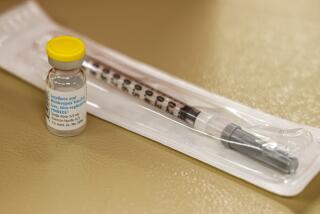Finding on AIDS Virus Infection Puzzles CDC
- Share via
CHICAGO — Although some medical authorities have said the chances of contracting an AIDS virus infection after one sexual encounter with a virus carrier are low, new research indicates that it can happen, government scientists reported Thursday.
Researchers from the Centers for Disease Control were puzzled by the findings, which they said suggested that sexual behavior alone does not explain heterosexual transmission of HIV, the virus that causes acquired immune deficiency syndrome.
“There’s three basic possibilities,” said Dr. Harold Jaffe of the Atlanta-based CDC. “There may be some people who are more infectious than others. There may be strains of the virus that are more infectious. Or there may be people who for whatever reason are more susceptible to infection.
“But, regardless, the public health message remains the same,” he emphasized. “The study shows that heterosexual transmission of HIV does occur, that it can occur in both directions, and that it can occur with only one sexual contact.”
Jaffe and his colleagues, reporting in the Journal of the American Medical Assn., based their findings on a continuing study of 106 families of patients who became infected with HIV through blood transfusions. The patients in the study had been infected an average of 31 months.
In 80 of the families, the infected person reported having sex with his or her spouse; two of 25 husbands and 10 of 55 wives subsequently became infected.
One infected woman had had only a single sexual encounter with her husband, and another had had only eight, yet 11 women remained uninfected after more than 200 sexual encounters with their husbands. The uninfected wives actually averaged more sexual contact than the infected women.
There were no significant differences in terms of type of sexual contact or methods of contraception, including use of condoms. No other AIDS risk factors could be found in the two men who became infected, although each had had several sexual encounters with their spouses.
Although the women were more than twice as likely as the men to become infected, and though the infected women were slightly older, no specific behavioral differences could be found between the infected and uninfected spouses.
An earlier study of women who had had sexual contact with HIV-infected men found that the females’ chances of infection was 1 in 1,000, and a study before that suggested the chance of transmission was less than 1% per exposure.
“Right now, it’s a mystery as to what’s going on,” Jaffe said. “We’re going to be looking very closely at these cases to try to determine what biologic factors are important to the transmission of this virus. It could have important implications in controlling this epidemic.”






